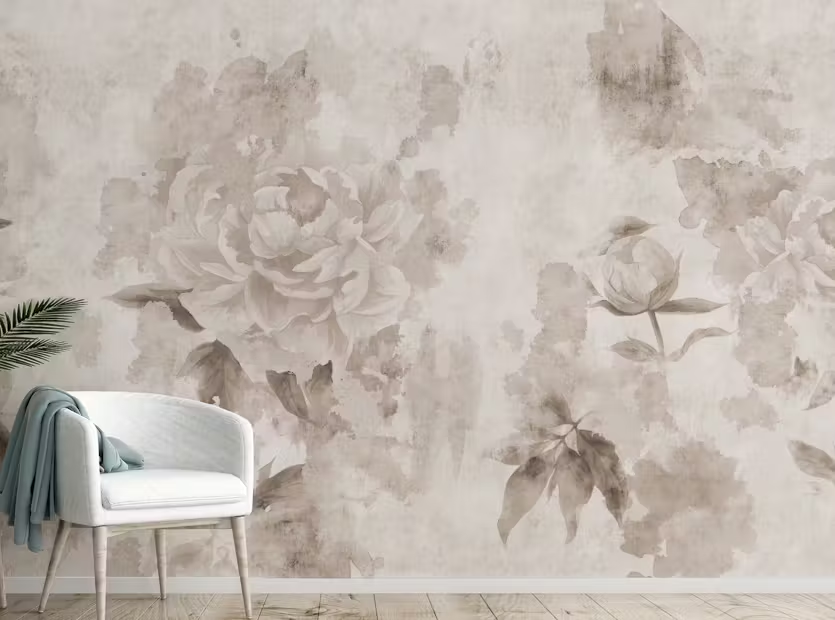Wallpaper has transformed dramatically over centuries, evolving from luxurious, hand-painted designs to modern innovations that reflect our latest technology and aesthetic sensibilities. From regal beginnings to today’s minimalist, eco-friendly options, wallpaper remains a versatile decor element, symbolizing personal style, artistic trends, and technical progress. Let's explore its journey through time and how it has continually adapted to the cultural and technological shifts of each era.
1. The Early Beginnings: Handcrafted Luxury
The history of wallpaper dates back to ancient China, where the earliest known wallpapers were created using rice paper, painted with birds, flowers, and landscapes. As early as 200 BC, artisans used techniques to bring the beauty of nature indoors, though these were mainly accessible to the wealthy due to the labor-intensive processes involved.
During the Middle Ages, Europe caught on to this decorative trend, using leather wall coverings with embossed designs. These were precursors to wallpaper, giving rooms a luxurious look and adding an extra layer of insulation in stone buildings. However, like in China, these early wall treatments remained an indulgence for the wealthy.
2. The 16th and 17th Centuries: Printmaking and Patterned Paper
The invention of printmaking revolutionized wallpaper in Europe. In the 16th century, artists began using woodblock printing to transfer patterns onto paper. These block-printed designs were highly decorative and soon became popular across France and England. One of the earliest known wallpapers, discovered in England, dates to around 1509, showcasing intricate patterns inspired by tapestries.
As more people sought ways to brighten and beautify their interiors, the demand for wallpaper grew. During this period, wallpaper designs often mimicked tapestries and paintings, featuring intricate landscapes, floral arrangements, and historical scenes. This gave rise to some of the most iconic designs, including floral patterns, pastoral scenes, and damask prints, styles still popular in some settings today.
3. The 18th and 19th Centuries: Mechanization and Mass Production
In the 18th century, wallpaper production entered a new era with the invention of machine printing. The English printer William Morris, a pioneer of the Arts and Crafts movement, contributed immensely to wallpaper’s popularity. He created wallpapers with intricate, naturalistic patterns that were easily reproducible thanks to new printing techniques.
Mass production made wallpaper accessible to the middle class for the first time, as mechanized processes reduced costs. Designs during this period became even more varied, from Rococo-inspired floral patterns to neoclassical motifs. By the 19th century, factories could produce wallpaper in rolls, and more households embraced wallpaper as an affordable way to beautify their homes.
4. The 20th Century: Innovation and Experimentation
The 20th century marked a period of bold experimentation with wallpaper. The Art Deco and Art Nouveau movements brought fresh, geometric, and curvilinear designs. Abstract patterns and exotic motifs became fashionable, moving away from the traditional floral and damask patterns of the past.
Post-World War II saw another shift, with the mid-century modern movement embracing simplicity, clean lines, and bold colors. Technological advances allowed for vinyl and washable wallpapers, revolutionizing maintenance and durability. This practical change broadened wallpaper’s appeal, making it more suitable for kitchens, bathrooms, and high-traffic areas.
In the 1970s, oversized prints and bright colors dominated interior design, allowing homeowners to make bold statements. However, the 1980s and 1990s saw wallpaper fall out of favor as minimalist trends encouraged neutral walls and bare spaces.
5. Modern Innovations: Digital Printing and Sustainable Design
Today, wallpaper is experiencing a renaissance. With digital printing, designers can create custom designs on demand, allowing homeowners to personalize their spaces like never before. From mural-style prints to photo-realistic images, digital printing has brought new possibilities to wallpaper, allowing for intricate details and unlimited color variations.
Sustainability is another innovation driving modern wallpaper design. Many manufacturers now prioritize eco-friendly practices, using recycled materials, water-based inks, and biodegradable papers. Peel-and-stick wallpaper has also become popular for its convenience and reusability, catering to renters and DIY decorators.
6. Smart and Interactive Wallpapers: The Future of Wall Coverings
Recent advances in technology are pushing the boundaries of what wallpaper can do. Some companies are exploring interactive wallpaper that responds to light or sound, creating immersive experiences that change based on the time of day or the presence of music. Others are experimenting with conductive inks that can be used to turn wallpaper into a touch-responsive interface, merging decor with technology.
3D wallpaper designs are also gaining traction, with textures that add depth and dimension to walls, creating a sense of luxury and sophistication. These innovations offer a glimpse into the future of wallpaper, where it will be more than just a decorative element but a functional, interactive feature of modern living spaces.
Conclusion
From its origins as a luxury item for the elite to its resurgence as a versatile, innovative design element, wallpaper has continually adapted to the evolving needs and tastes of society. Today, it stands at the intersection of art and technology, offering more choices, personalization, and sustainability than ever before. As designers and manufacturers continue to push creative and technological boundaries, wallpaper remains a timeless way to transform our living spaces, capturing both history and the promise of the future within our walls.






Comments